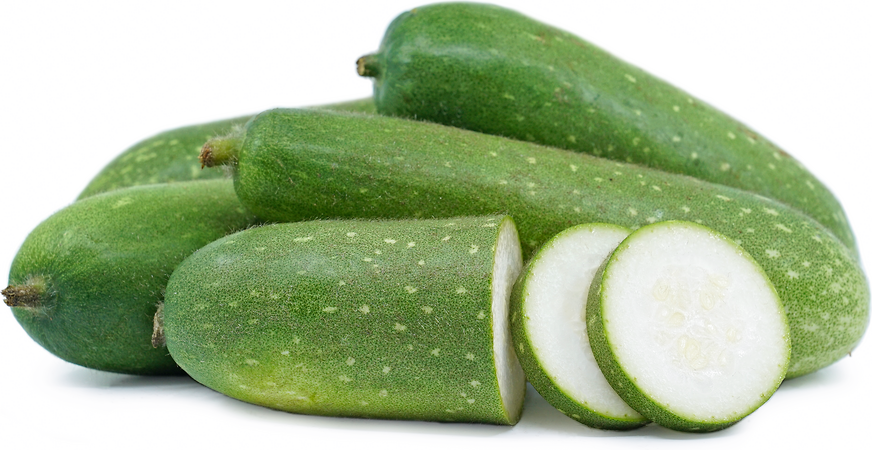


Bottle Gourd
Estimated Inventory, lb : 0
Description/Taste
Bottle gourd can vary in size shape and length depending on how it is grown and when it is harvested. It can be short and round, uniformly cylindrical, curved, bulbous, or extremely long and thin. Its skin is most often smooth though there are some varieties that are covered in fine hairs. Its coloring can vary from a light green or chartreuse to dark green. The interior flesh is creamy white with petite seeds that when young are tender and edible but when more mature become hard and should be removed prior to consumption. Young bottle gourd squash offers a mild flavor reminiscent of summer squash and cucumber with a firm texture.
Seasons/Availability
Bottle gourd is found growing year-round in tropical climates.
Current Facts
Bottle gourd, botanically a part of Lagenaria siceraria is a vine and a member of the Cucurbitaceae family. When young it is utilized as a vegetable in preparations similar to that for squash and once mature it can be dried and hollowed out to make utensils, musical instruments and vessels. The Bottle gourd has a rich history and was one of the first cultivated plants in the world. It is known today by many different names throughout the world, most notably as a Calabash, Opo, Cucuzza and Long melon.
Nutritional Value
Bottle gourd is low in calories and provides small amounts of vitamin C, folate, calcium, iron, zinc and B vitamins. It is also rich in fiber and is believed to help aid in healthy digestion. The juice of Bottle gourd is touted for its vitamin C and zinc content as well as for its ability to potentially regulate blood sugar levels. In India the juice is popularly consumed as a health benefiting beverage. Caution should be used however as to never consume Bottle gourd juice that has developed a bitter flavor as it may contain toxins that can cause ulcers, extreme harm to the digestive track and in some cases even fatality.
Applications
Young Bottle gourd is used most often in cooked applications. When very young it can be utilized with skin on or when slightly more mature the skin can be removed for a more tender texture. When young Bottle gourd can be used in a fashion similar to that of zucchini. It can be sautéed, fried, pickled or grilled. Add cubed Bottle gourd to curries or grate and add to batter for quick breads, cakes and fritters. More mature Bottle gourd is great for slow roasting, baking and pureeing for soups and stews. Mature Bottle gourd is also ideal for hollowing out slightly, stuffing and baking. In Northern India Bottle gourd is combined with channa dal to make a dish known as lauki channa. In Maharashtra, India the skin of the Bottle gourd is used to make a chutney preparation. In China where it is known as Opo it is popularly used in stir fries and soups or stuffed and steamed. In Central America the seeds are toasted and ground with rice, cinnamon and allspice to make a beverage known as horchata. Its flavor and texture pair well with eggplant, tomato, onion, chile peppers, fennel, ginger, garlic, chickpeas, lentils, coconut milk, pork, shellfish and roasted meats. To store keep Bottle gourd dry and refrigerated. For best flavor and texture use within two to three weeks.
Ethnic/Cultural Info
In addition to being a food source when fresh the dried Bottle gourd has long been used throughout the world for an array of purposes. In Africa the dried Bottle gourd has a rich history of use as a vessel for water and rice, larger Bottle gourds are dried and used as hats for sun protection and as motorcycle helmets. Additionally in Africa the soccer stadium that hosted the FIFA World Cup was designed to model the shape and color of the dried Bottle gourd, a nod to its historical importance. In India the Bottle gourd is dried and used to make the base of musical instruments such as the sitar and tanpura. In rural parts of Mexico the dried Bottle gourd is used as a canteen for water and are known as “bule” or “guaje”. In South America the Bottle gourd is dried and carved into a “mate”, the traditional vessel for drinking the popular yerba mate tea-like beverage. In the Caribbean the word “Calabash” is used as a way to describe the natural lifestyle of Rastafarians. In Hawaii dried Bottle gourds were commonly used on tables as a centerpiece and bowl, the term "Calabash Family" or "Calabash cousins" is commonly used there to refer to the closeness of family and friends sharing meals.
Geography/History
Bottle gourd is believed to be one of the first cultivated plants of the world and was domesticated over 10,000 years ago in Africa. Studies done by the National Academy of Sciences in 2005 indicate it was domesticated earlier than livestock and food crops and was likely brought to the New World by Paleo Indians at the end of the Ice Age. Throughout time it has made its way across the world via human migration and today is known by many different names depending upon where it is found. It has long been used as a staple in Indian cuisine where it is known as Lauki and Sorakaaya. In China it is also known as Opo, Hulu and Moa Gua, in the Philippines as Upo, and in Italy as Cucuzza. Today the Calabash can be found growing around the world, thriving in tropical and sub-tropical climates.
Recipe Ideas
Recipes that include Bottle Gourd. One














